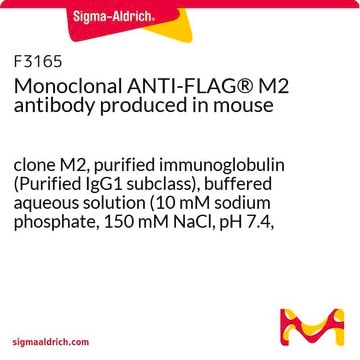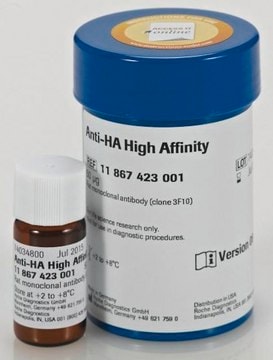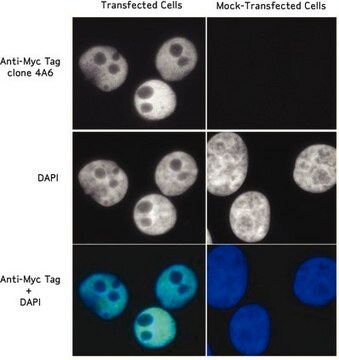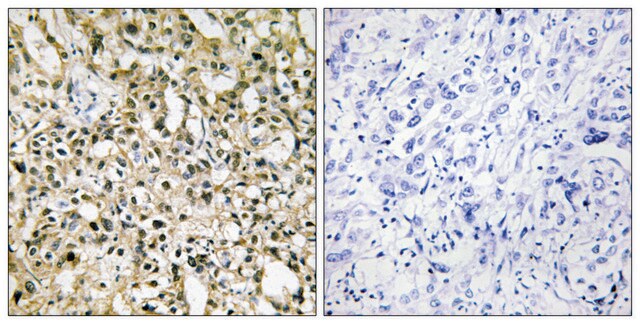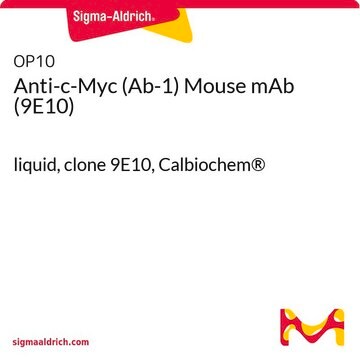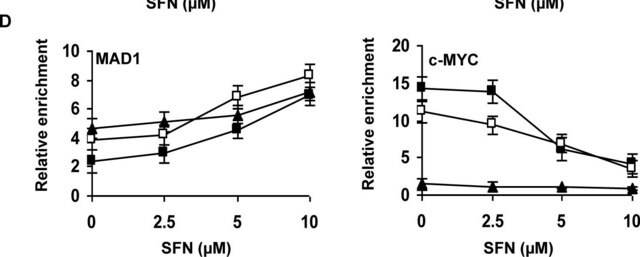ROAMYC
Roche
Anti-c-myc
from mouse IgG1κ
Synonym(s):
anti-myc
Sign Into View Organizational & Contract Pricing
Select a Size
All Photos(1)
Select a Size
Change View
About This Item
UNSPSC Code:
12352203
Recommended Products
biological source
mouse
Quality Level
conjugate
unconjugated
antibody form
purified immunoglobulin
antibody product type
primary antibodies
clone
9E10, monoclonal
assay
90% (SDS-PAGE)
form
frozen liquid (11667203001)
lyophilized (11667149001)
packaging
pkg of 200 μg (11667149001)
pkg of 5 mg (11667203001 [1 ml])
manufacturer/tradename
Roche
General description
Anti-c-myc is a monoclonal antibody to c-myc peptide (clone 9E10). Anti-c-myc recognizes the 9E10 epitope sequence (EQKLISEEDL), derived from the human c-myc protein. The monoclonal antibody against the c-myc epitope is well characterized and does not cross-react with other cellular proteins. The antibody recognizes its antigenic determinant even when the c-myc peptide epitope is introduced into unrelated recombinant proteins by a technique known as epitope tagging.
The cellular myelocytomatosis (c-myc) is the cellular homologue of the v-myc gene originally isolated from an avian myelocytomatosis virus. The gene encoding it is mapped to human chromosome 8q24. It c-myc is a member of MYC gene family. c-Myc gene codes for basic helix-loop-helix/leucine zipper (bHLH/LZ) transcription factor that regulates the G1-S cell cycle transition.
Contents:
The cellular myelocytomatosis (c-myc) is the cellular homologue of the v-myc gene originally isolated from an avian myelocytomatosis virus. The gene encoding it is mapped to human chromosome 8q24. It c-myc is a member of MYC gene family. c-Myc gene codes for basic helix-loop-helix/leucine zipper (bHLH/LZ) transcription factor that regulates the G1-S cell cycle transition.
Contents:
- 11 667 149 001: lyophilizate, stabilized
- 11 667 203 001: frozen solution, (5 mg/ml)
Specificity
Anti-c-myc recognizes the amino acid sequence EQKLISEEDL, which was derived from the human c-myc protein. The antibody recognizes its antigenic determinant even when the c-myc peptide epitope is introduced into unrelated recombinant proteins either N-terminal, C-terminal or internal. The monoclonal antibody against the c-myc epitope is well characterized and does not crossreact with other cellular proteins.
Immunogen
Amino acid sequence EQKLISEEDL was derived from the human c-myc protein.
Application
Use Anti-c-myc for the detection of native human c-myc protein and recombinant epitope-tagged proteins that contain the c-myc epitope using:
- Dot blots
- Immunocytochemistry
- Immunoprecipitation
- Western blots
- Immunohistochemistry.
Biochem/physiol Actions
The cellular myelocytomatosis (c-myc) oncogene has a crucial role in cellular proliferation, differentiation, apoptosis and acts as transcriptional regulator of gene expression. c-myc expression is essential and sufficient to assist most of the cells to enter DNA synthetic (S) phase of the cell cycle. The encoded protein plays a crucial role in vasculogenesis and angiogenesis during cancer development and progression. c-myc interacts with its binding partner Max and activates the transcription of growth promoting genes such as cyclin D2 and ornithine decarboxylase. It also represses the transcription of multiple genes, especially p21 and p27, by binding to the transcription initiator element (Inr) in a complex with Max and either Sp1 (specificity protein 1) or Miz1 (Myc-interacting zinc finger protein 1). Overexpression of MYC in DLBCL (diffuse large B-cell lymphoma) results in poor outcome and invasive treatment when medicated with rituximab plus cyclophosphamide, doxorubicin, vincristine and prednisone (R-CHOP).
Quality
Anti-c-myc antibody is tested for functionality and purity relative to a reference standard to confirm the quality of each new reagent lot.
Preparation Note
Working concentration: Working concentration of conjugate depends on application and substrate.
The following concentrations should be taken as a guideline:
Working solution: Tris-buffered saline containing 0.1% Tween 20.
The following concentrations should be taken as a guideline:
- Western blot: 1 to 10 μg/ml
Working solution: Tris-buffered saline containing 0.1% Tween 20.
Reconstitution
Add 500 μl PBS to a final concentration of 400 μg/ml.
Analysis Note
The monoclonal antibody against the c-myc epitope is well characterized and does not crossreact with other cellular proteins. No cross reaction with murine c-myc.
Other Notes
For life science research only. Not for use in diagnostic procedures.
Not finding the right product?
Try our Product Selector Tool.
Storage Class
11 - Combustible Solids
flash_point_f
does not flash
flash_point_c
does not flash
Choose from one of the most recent versions:
Already Own This Product?
Find documentation for the products that you have recently purchased in the Document Library.
Customers Also Viewed
Ines B Folger et al.
Nature chemical biology, 20(6), 761-769 (2024-02-03)
Engineered biosynthetic assembly lines could revolutionize the sustainable production of bioactive natural product analogs. Although yeast display is a proven, powerful tool for altering the substrate specificity of gatekeeper adenylation domains in nonribosomal peptide synthetases (NRPSs), comparable strategies for other
Apoptotic signaling by c-MYC.
Hoffman B and Liebermann D A
Oncogene, 27(50), 6462-6472 (2008)
R Dalla-Favera et al.
Proceedings of the National Academy of Sciences of the United States of America, 79(24), 7824-7827 (1982-12-01)
Human sequences related to the transforming gene (v-myc) of avian myelocytomatosis virus (MC29) are represented by at least one gene and several related sequences that may represent pseudogenes. By using a DNA probe that is specific for the complete gene
HIF-2alpha promotes hypoxic cell proliferation by enhancing c-myc transcriptional activity.
Gordan JD, et al.
Cancer Cell, 11(4), 335-347 (2007)
c-Myc is essential for vasculogenesis and angiogenesis during development and tumor progression.
Baudino T A, et al.
Genes & Development, 16(19), 2530-2543 (2002)
Our team of scientists has experience in all areas of research including Life Science, Material Science, Chemical Synthesis, Chromatography, Analytical and many others.
Contact Technical Service

